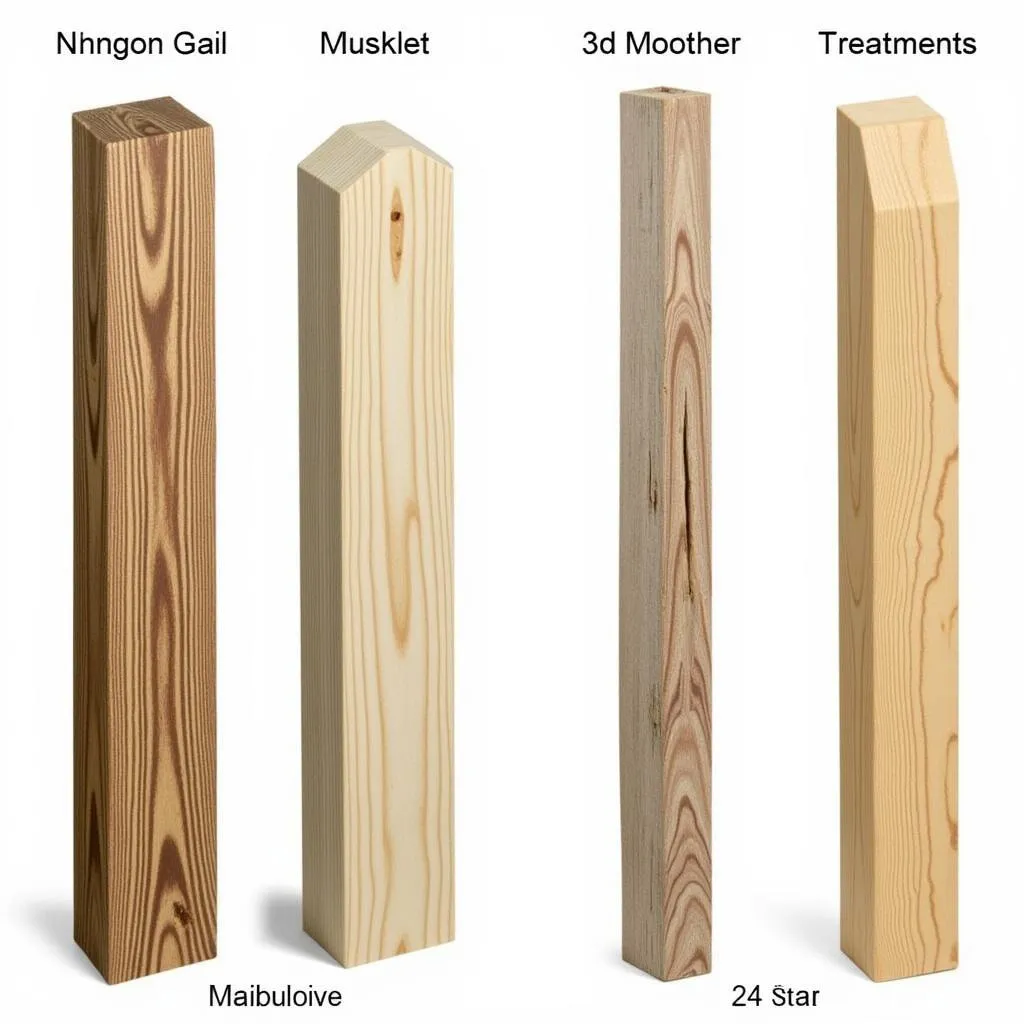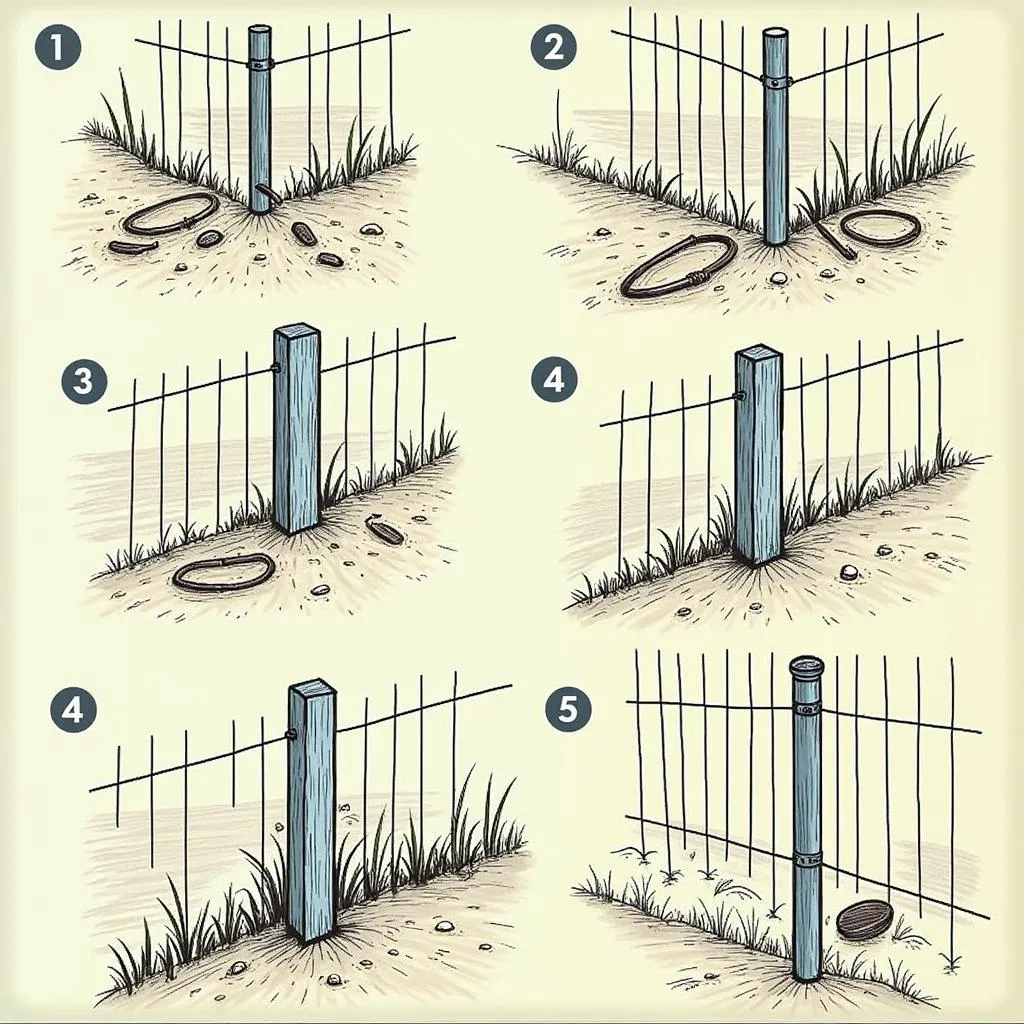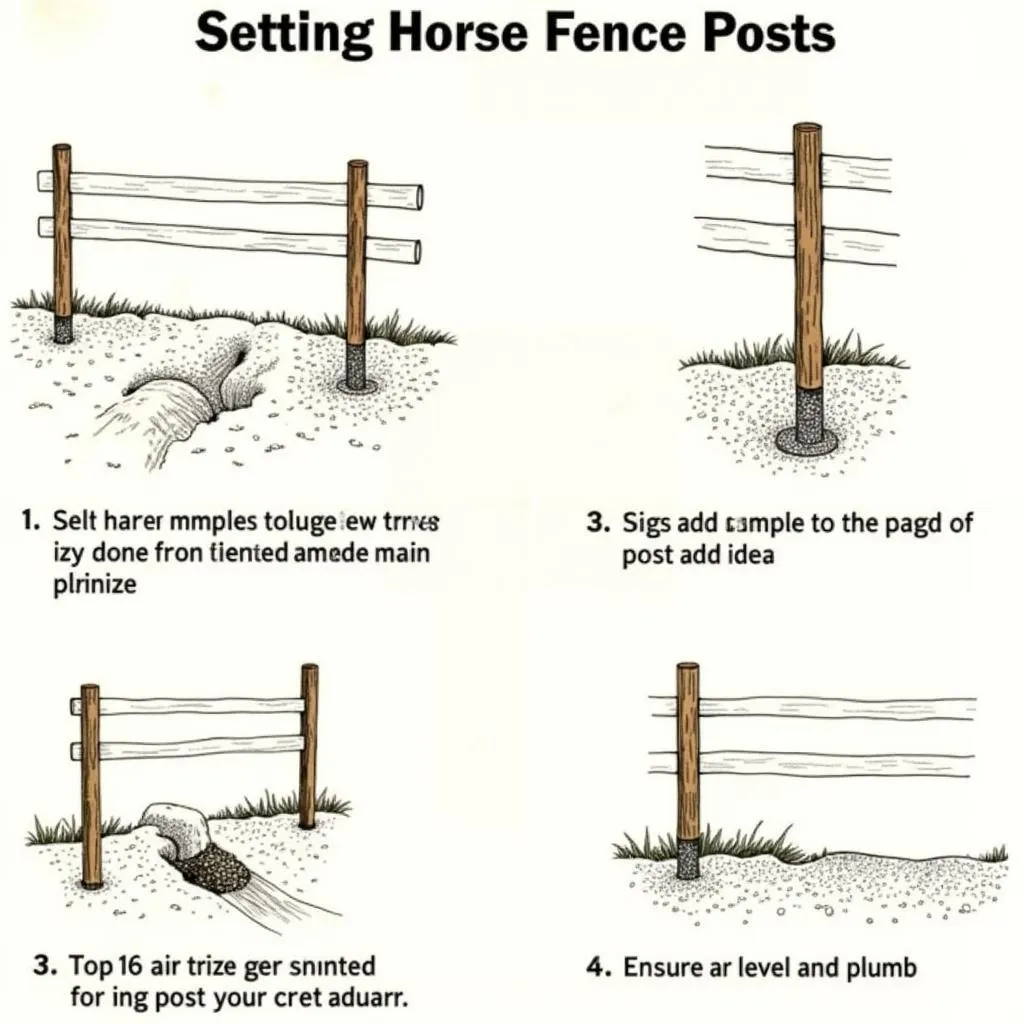Selecting the right fence posts is crucial for building a safe and secure horse fence. The type of Horse Fence Post you choose will impact the longevity, strength, and overall effectiveness of your fencing system. This guide will explore the different types of horse fence posts available, factors to consider when choosing, and tips for proper installation.
Types of Horse Fence Posts
Wooden Fence Posts
 Types of Wooden Fence Posts
Types of Wooden Fence Posts
Wooden posts are a classic choice for horse fencing, offering a natural look and good affordability. However, it’s essential to select rot-resistant wood like cedar, redwood, or pressure-treated pine.
Pros:
- Cost-effective: Wooden posts are generally more budget-friendly compared to other materials.
- Natural aesthetic: They blend well with rural settings and offer a traditional look.
- Easy to work with: Wood can be easily cut, shaped, and installed using common tools.
Cons:
- Susceptible to rot and insect damage: Even treated wood requires ongoing maintenance and has a limited lifespan.
- Can be less durable: Compared to metal or vinyl, wood can be prone to damage from impact or harsh weather.
Metal Fence Posts
Metal posts provide exceptional strength and durability, making them a popular choice for horse fencing. Common options include steel and aluminum.
 Metal Fence Posts Installation
Metal Fence Posts Installation
Pros:
- Strength and longevity: Metal posts resist rot, insects, and weather damage, offering a longer lifespan.
- Low maintenance: They require minimal upkeep, making them a convenient choice.
- Available in various styles: Metal posts can be found in different finishes and designs to suit your aesthetic preferences.
Cons:
- Higher initial cost: Metal posts typically cost more upfront than wooden posts.
- Susceptible to rust: While some metals are more resistant, rust can be a concern and may require treatment.
Vinyl Fence Posts
Vinyl fence posts have gained popularity in recent years due to their durability and low maintenance requirements.
Pros:
- Exceptional durability: Vinyl resists rot, insects, fading, and weathering, making it a long-lasting option.
- Virtually maintenance-free: Vinyl posts don’t require painting or staining.
- Variety of styles and colors: They are available in various colors and styles to complement your property.
Cons:
- Higher upfront cost: Vinyl posts are typically the most expensive option upfront.
- Can be less sturdy than metal: While durable, vinyl can be prone to damage from significant impact.
Factors to Consider When Choosing Horse Fence Posts
1. Soil Type
The type of soil on your property plays a crucial role in determining the appropriate fence post material and installation method. Loose soil may require deeper post holes or additional support, while rocky soil may necessitate specialized installation techniques.
2. Terrain and Fence Line
Consider the terrain and layout of your fence line. Uneven terrain may require adjustments to post spacing or the use of different post heights. Curves or changes in elevation may also necessitate specific post types or bracing.
3. Climate
Your local climate will influence the lifespan and performance of your fence posts. Areas with extreme temperatures, high winds, or heavy snowfall may require more durable materials or additional support structures.
4. Budget
Establish a clear budget for your fencing project. Wooden posts offer the most budget-friendly option, followed by metal and then vinyl. Factor in the cost of materials, installation, and potential maintenance when making your decision.
Installing Your Horse Fence Posts
Setting the Posts
 Setting Horse Fence Posts
Setting Horse Fence Posts
- Digging Post Holes: The depth and width of the hole will depend on the height of your fence and the soil type. As a general rule, bury at least one-third of the post length.
- Adding Gravel: Backfill the hole with gravel to promote drainage and prevent the post from heaving in freezing temperatures.
- Setting the Post: Place the post in the hole and use a level to ensure it is plumb (perfectly vertical). Backfill the hole with soil or concrete, tamping it down firmly to secure the post.
Bracing Corner Posts
Corner posts endure significant stress, so proper bracing is crucial. Use diagonal braces or H-braces to reinforce these posts and prevent them from leaning or pulling away from the fence line.
Maintaining Your Horse Fence
Regular inspection and maintenance will prolong the life of your fence posts and keep your horses safe.
- Inspect for Damage: Regularly check for signs of rot, insect damage, rust, or loose posts. Address any issues promptly to prevent further deterioration.
- Repaint or Seal (Wooden Posts): Reapply paint, stain, or sealant to wooden posts as needed to protect them from moisture and UV damage.
- Tighten Hardware: Periodically check and tighten all nuts, bolts, and screws on your fence posts and hardware.
Choosing the right horse fence posts is a crucial investment for the safety and well-being of your horses. By considering the factors outlined in this guide and following proper installation and maintenance practices, you can ensure a durable and reliable fencing system for years to come.
Frequently Asked Questions About Horse Fence Posts
1. How far apart should horse fence posts be spaced?
The ideal spacing for horse fence posts is typically 8-12 feet. However, this can vary based on the terrain, fence style, and the size and temperament of your horses.
2. What is the best type of wood for horse fence posts?
Rot-resistant woods like cedar, redwood, and pressure-treated pine are excellent choices for horse fence posts.
3. How deep should I dig a hole for a horse fence post?
As a general rule, bury at least one-third of the post length. For example, an 8-foot post should be buried at least 2.5 feet deep.
4. Do I need to brace every fence post?
While it’s not necessary to brace every post, corner posts, gate posts, and any posts at changes in elevation or direction should be adequately braced for added stability.
5. How do I protect my metal fence posts from rust?
Choose metal posts with a rust-resistant coating or apply a rust-inhibiting primer and paint. Regularly inspect for and address any signs of rust promptly.
Remember, creating a safe and secure environment for your horses is paramount. If you’re unsure about choosing or installing horse fence posts, consulting with a fencing professional is always recommended.
For additional information on horse fencing and other equestrian needs, explore our website. You can find specific resources like our articles on horse hay feeders field, 72 inch no climb horse fence, and electric fence kit for horses. We aim to provide comprehensive information to support horse owners in creating a safe and enriching environment for their equine companions.
Need help getting your horse show ready? Check out our guide to jump start horse trials.
When it comes to your horses’ safety and well-being, don’t leave it to chance. Contact Justus Horses USA today. Call us at 0772127271, email us at [email protected] or visit our location at QGM2+WX2, Vị Trung, Vị Thuỷ, Hậu Giang, Việt Nam. Our dedicated team is available 24/7 to answer your questions, provide expert advice, and assist you in finding the perfect fencing solutions for your equine partners.